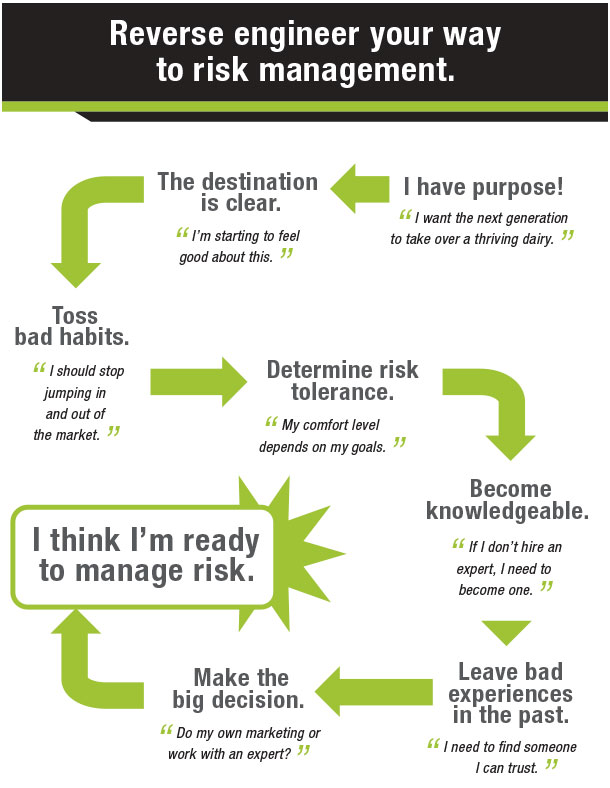A market correction is a common trigger to start marketing. After a painful correction, frustration sets in, and risk management receives more attention. Some farmers will begin managing marketing on their own.
Others will turn to a market adviser for help. The same can be said about the kind of price slump we’re in right now.
Neither scenario is an optimum time to start marketing. Any time someone undertakes something largely because they feel forced to do it, they’re less mentally open to overcome challenges that may arise.
This is especially true with farm marketing. There will be bumps. Encountering a period of sustained difficulty, such as a milk statement reflecting forward-contracting losses for a few straight months, can make you think marketing hasn’t ever been worthwhile.
It’s different when you start marketing for reasons that go beyond price. Price is, of course, important. Having a purpose, however, is what keeps you going.
Start with purpose
Did you begin dairy farming for the love of working with dairy cattle? To run your own business? Whatever your purpose for dairy farming, you may have encountered pessimists with their “Are you sure you want to do that?” discouragements.

People with purpose aren’t dissuaded by naysayers. Purpose is the fuel of perseverance. If production numbers are down, herd health issues arise, or personnel management is a struggle, purpose can sustain you. It provides the emotional fortitude to get creative and figure out how to make things work.
Farmers who stick with marketing in good times and bad usually have a strong purpose marketing helps them attain. They are less vulnerable to emotional chaos, the voice inside their heads that sows doubt and confusion during times of market volatility or low prices.
Key point: If you think you want to start marketing, identify your purpose. With purpose driving you, you’re more likely to achieve objectives.
Toss bad habits
There’s a long list of cognitive biases, or mental traps, most of us fall into. They make for bad habits. Make addressing them your next step.
One bias we’ve written about in the past is anchoring. It’s the inclination to rely heavily on, or anchor to, a single piece of information. It’s a trap because the information you’re clinging to might be inaccurate. Even accurate information over time can become outdated.
If you anchor to the outlook that says low feed prices will remain low for a long time to come, you could get caught flat-footed by a price spike.
Here’s another. Let’s assume, for purpose of explanation, you believe the price of soybean meal will stay where it’s at or go lower. You may be inclined to believe only data that support your belief. A behavioral economist would consider that confirmation bias, a greater belief in opinions that support what you already believe.
Key point: Emotions play a role here too, as they feed bad habits. In marketing, it helps to think like a mathematician. Act rationally and decisively.
Determine risk tolerance
Your comfort level with risk depends on your goals. A good farm marketing adviser can help you accurately determine your tolerance.
In your own experience thus far, do you think you overestimate or underestimate how much risk you’re willing to take on? Research has shown a person’s stated tolerance level often doesn’t match their actual behavior.
There’s a good chance your actual behavior will be driven by past experiences or an outlook on the future. Neither is necessarily a good barometer for identifying tolerance. And both might be driven by emotion.
If your past marketing experiences were poor, ask yourself why. You may realize the culprit was a poor approach to marketing, such as a lack of discipline, knee-jerk decision-making or the risky act of jumping in and out of marketing.
Key point: Being honest with yourself about risk tolerance will increase your ability to stick with marketing down the road. And remember, your tolerance level will shift as your business evolves.
Become knowledgeable
The next step is to become knowledgeable about commodity marketing and the tools for managing risk. But how much do you need to know?
If you plan to manage risk by yourself, you likely will need to invest a significant amount of ongoing time into education. That’s a different and much longer topic to cover. If you think you’d like to hire an adviser, learn enough about risk management tools to understand the basic what, how and why about them.
Key point: Learning influences attitude and behavior. Typically, this is a good thing. It’s bad when experience has taught you something erroneous. A classic example is believing hedging tools, like options, are a waste of money. A poor experience is not a good teacher.
Leave bad experiences in the past
Unlike the act of discarding bad habits, this step has more to do with choosing someone to help you manage risk.
A bad past advisory experience might have you feeling less than enthusiastic about looking for someone new. Fortunately, what happened in the past doesn’t mean you’ll face a similar future outcome here. In fact, your past is fertile learning ground.
Key point: Take what you’ve learned and apply it to the future. Talk through your bad past experiences with whomever you’re considering for help. Make known what you expect to avoid and what you hope to achieve.
You’re ready to manage risk
Every day, you manage risk on the dairy, whether related to the herd, facilities, people, equipment and more. Managing price can be just as rewarding, especially when you start with purpose. ![]()
Beth Rousseau is vice president of marketing and communications at Stewart-Peterson in West Bend, Wis. Stewart-Peterson manages market opportunities and risks for anyone whose margins are affected by commodity price fluctuations.
Futures trading is not for everyone. The risk of loss in trading is substantial. Therefore carefully consider whether such trading is suitable for you in light of your financial condition.





